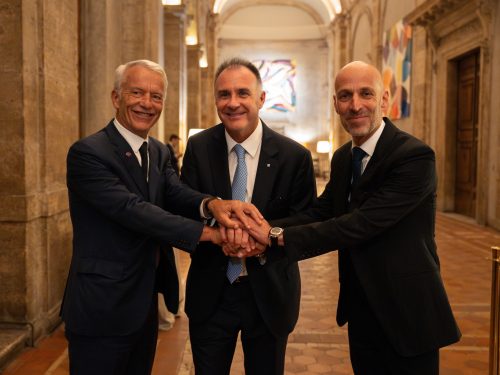News
Share on
For Italian industry, which is strongly export-oriented, transport and logistics are real levers of competitiveness. Today, with a view to strengthening European connections and given the need to increase complementarity between logistics and production, the NRP represents an opportunity for Italy to establish itself as a bridge between Northern Europe and the Mediterranean, Confindustria has taken an active role in promoting initiatives aimed at integrating logistics and transport supply and demand.
For this, together with the Association System, drew up the document 'Industry, Transport, Logistics and Infrastructure: TOGETHER for the competitiveness of the country', identifying new strategic lines of industrial policy in this area that has been presented on 23 January in Viale dell'Astronomia.
The logistics and transport system growsfor several years, at rates well above those of GDP. The the total value of logistics activities in Italy in 2023 is 135.4 billion euro, 8.2% of Italian GDP, and employs approximately 1.4 million people working in the sector. La outsourced logistics accounted for 45.3%, or EUR 61.3 billion, net of intra-sector trade.
The growing weight of exports makes The issue of investment and planning, in the medium and long term, in the transport and infrastructure sectors is increasingly central. More than 60% of Italian trade takes place with other European countries. Alpine crossings therefore play a decisive role for both rail and road transport.
The growth of non-European markets leads to focus focus also on the development of ports and airports.
The modern logistics system must be a factor of competitiveness for the manufacturing sector, with which there is an inherent interdependence. We need to get out of the perspective in which logistics and transport are seen only as a cost and not as a competitive asset to be leveraged. In Italy, distribution-oriented logistics is clearly preponderant. Moreover, compared to other EU countries, the road component is very strong and the mix is less balanced. The logistics offer, which is so fragmented, is less cost-competitive than the large international operators.
Within the framework of the proposals for the development and modernisation of national transport and logisticsit is, first of all, necessary to improving infrastructure planning and the quality of projects and works to be realised. It emerges the need for efficient regulation of public contractsof a proper functioning of the port system and the definition of an effective national airport plan. Le bureaucratic procedures must be simplified and digitised and removed obsolete constraints and bottlenecks.
Regarding the specific areas of intervention:
- the first step concerns the management of Alpine crossings (through which 60% of Italian trade passes). There is a lack of a national vision, a stronger role for the EU and an analysis of the development scenario for crossing traffic;
- The second area of intervention is intermodalitywhere infrastructure and service inefficiencies lead to an unfavourable quality/price ratio of supply. A useful counterbalance is the Ferrobonus and the Marebonus (Sea modal shift), which, however, must be given more funding;
- The third area of intervention should focus on on logistics infrastructure, such as interports;
- for the maritime transport needs a renewed industrial strategy aiming above all at the simplification of bureaucratic processes through digitisation, to the targeted investment of new resources, to ensure the independence of the national supply chain;
- at air cargo sector, the national strategy should aim to ensure competitive levels with the main European airports, via simplification of customs procedures, digitisation of airport logistics systems and the effective integration of airports with other transport networks (development of airport cargo cities);
- for the digitisation in the transport sector, it is necessary to stimulate the use of operational applications and certain technologies such as Big Data, Blockchain, Cybersecurity and AI. Public policies are also needed to promote the automation of logistics warehouses and distribution centres and the digitisation of transport companies and the entire logistics chain;
- for the movement of goods, the objectives must combine efficiency, security and continuity of production and logistics. A modernisation of the national calendar of bans, its harmonisation at EU level, revision of the regulations on exceptional transport and, as far as dangerous goods are concerned, a clearer definition of the so-called 'technical' stop;
- another area for action is the renewal of the vehicle fleet in a 'green' perspective, with a reform of the Road Transport Investment Fund, with an appropriate budget for the period 2023-2026;
- for energy vectorsthe logistics infrastructure is called upon to ensure high levels of flexibility and adaptability to ensure continuity of supply, even of the most innovative fuels. To this end, authorisation procedures must be simplified and accelerated;
- on the energy requirements of logistics buildings and their location, one must aim on the capacity for self-production and self-consumption of energy by logistics companies, supporting their investment in the purchase of storage systems and the installation of charging stations for electric vehicles.
In addition, the issue of the human capitalits training and recruitment is an obstacle to the development of the logistics sector. To overcome this, it would be necessary to supplement the training courses of technical institutes with specific courses, to revise training programmes in agreement with companies in the sector and to push for the employment of the immigrant workforce.
Finally, it is necessary a careful review of the role of the Transport Regulatory Authorityespecially with regard to its scope and financing, which excessively involves companies in the logistics and transport sector.
The complete document is attached.
Attachments


















